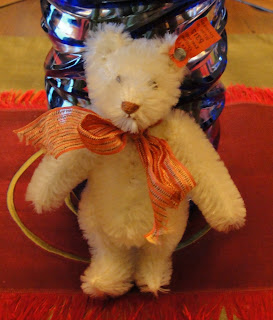There's a definite chill in the air as we head into the winter season around here. Keeping warm is important - yes, even for Steiff collectibles! And speaking of bundling up, check out this note from a reader who asks about a blanket for her newly acquired tiger. Through a series of correspondences, Katrina from the United Kingdom writes:
"Hi,
We are hoping you can tell us more about our Steiff tiger.
His physical condition and appearance is excellent - almost like new. His length is 11" from his nose to the end of his tail and 4" from the tops of his ears to the bottoms of his feet. He has his button and yellow tag and looks straight away to be a Princeton tiger. However, when we purchased him, he did not have the Princeton blanket, and there is no indication he ever had one, as there is no fading to the area around where a blanket would have been.
In addition, the Sortiment book does not say the Princeton tiger was numbered and ours is 1314,0. Other than the Princeton tiger, we cannot find any tiger that has eyes like ours. Any information you can give would be greatly appreciated.
His physical condition and appearance is excellent - almost like new. His length is 11" from his nose to the end of his tail and 4" from the tops of his ears to the bottoms of his feet. He has his button and yellow tag and looks straight away to be a Princeton tiger. However, when we purchased him, he did not have the Princeton blanket, and there is no indication he ever had one, as there is no fading to the area around where a blanket would have been.
In addition, the Sortiment book does not say the Princeton tiger was numbered and ours is 1314,0. Other than the Princeton tiger, we cannot find any tiger that has eyes like ours. Any information you can give would be greatly appreciated.
Many thanks,
Katrina"
Steiffgal can't wait to get started on this "Ivy League" inquiry! Yes, she is all but certain that this tiger is the Princeton tiger, sans blanket. Steiff made a series of college mascot exclusives in the 1950's, including a Brown University bulldog, a Columbia University lion and lioness pair, a Duke University devil, two versions of the Yale University bulldog, and three versions of the Princeton University tiger. Most had felt blankets bearing the first initial of the school. The Princeton tiger was produced standing in 10 and 25 cm and sitting in 25 cm; Katrina's version is the 10 cm standing version. According to company records, the 10 cm Princeton tiger left the Giengen factory with green and black "squint" style eyes and either an orange and black blanket or a navy blue and white jacket.
And what about this jacket which appears to have gone missing? It is quite possible that he lost it somewhere along the way, or that he never left the factory with one (which does happen once in awhile!) This phenomenon was documented in the catalog of the recent Christie's Steiff auction in London concerning a lot of two "blanket free" items, a US Navy mascot goat and a seated Princeton University seated tiger. According to the Christie's specialists, "Both these items should have a felt coat, there appears to be no sign where these were attached, so it is possible that they were issued without them."
This tiger also has some fantastic eyes worth exploring a little more. Similar style eyes are seen on Steiff's playful character style items - Steiff uses unusual eyes to indicate that an item is jolly, youthful, and not to be taken too seriously. The use of "distinctive" cartoonish eyes most likely started in the late 1920's when Steiff used them to lend a lighthearted look to their "Petsy" baby bear and "Cheerio" laughing dog designs. It is interesting to note that Steiff used similar green and black eyes on Katrina's treasure as on their playful series of 1950's era mohair dinosaurs.
This tiger also has some fantastic eyes worth exploring a little more. Similar style eyes are seen on Steiff's playful character style items - Steiff uses unusual eyes to indicate that an item is jolly, youthful, and not to be taken too seriously. The use of "distinctive" cartoonish eyes most likely started in the late 1920's when Steiff used them to lend a lighthearted look to their "Petsy" baby bear and "Cheerio" laughing dog designs. It is interesting to note that Steiff used similar green and black eyes on Katrina's treasure as on their playful series of 1950's era mohair dinosaurs.
As for the listing of this item in the Steiff Sortiment books, well, nothing is ever 100% perfect. Although Gunther Pfeiffer's books are considered the gold standard for Steiff collectors globally, they are not perfect and do have some mistakes and omissions. In this case, this mascot's article number 1312,0 was not included in these reference materials. Steiffgal supposes that's bound to happen when you need to catalog thousands of items produced over a century plus time frame.
Steiffgal hopes this discussion on university mascots and their blankets has left a warm spirit in your heart!
Have a question about one of your Steiff treasures? Let's talk! Click here to learn more.
Have a question about one of your Steiff treasures? Let's talk! Click here to learn more.


















